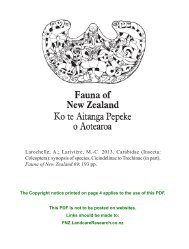Fauna of NZ 45 - Landcare Research
Fauna of NZ 45 - Landcare Research
Fauna of NZ 45 - Landcare Research
Create successful ePaper yourself
Turn your PDF publications into a flip-book with our unique Google optimized e-Paper software.
<strong>Fauna</strong> <strong>of</strong> New Zealand <strong>45</strong> 13<br />
(Table 1 continued)<br />
Angiospermae<br />
Araliaceae<br />
Pseudopanax arboreus: Aralius wollastoni<br />
Pseudopanax crassifolius: Aralius wollastoni<br />
Pseudopanax lessonii: Aralius wollastoni<br />
Asteraceae<br />
Brachyglottis repanda: Lasiorhynchus barbicornis<br />
Olearia nummulariifolia: Agathinus tridens*<br />
Cornaceae<br />
Corokia buddleioides: Agathinus tridens*<br />
Corynocarpaceae<br />
Corynocarpus laevigatus: Lasiorhynchus barbicornis<br />
Eleocarpaceae<br />
Aristotelia serrata: Pachyurinus sticticus*<br />
Epacridaceae<br />
Cyathodes sp.: Agathinus tridens*<br />
Ericaceae<br />
Gaultheria sp.: Agathinus tridens*<br />
Fabaceae<br />
Ulex europaeus: Exapion ulicis<br />
Fagaceae<br />
Noth<strong>of</strong>agus cliffortioides: Pachyurinus sticticus*<br />
Noth<strong>of</strong>agus menziesii: Cecidophyus noth<strong>of</strong>agi<br />
Noth<strong>of</strong>agus solandri: Pachyurinus sticticus*<br />
Malvaceae<br />
Hoheria sp.: Lasiorhynchus barbicornis<br />
Meliaceae<br />
Dysoxylum spectabile: Lasiorhynchus barbicornis<br />
Monimiaceae<br />
Hedycarya arborea: Lasiorhynchus barbicornis<br />
Laurelia novae-zelandiae: Lasiorhynchus barbicornis<br />
Myrtaceae<br />
Metrosideros albiflorus: Neocyba metrosideros<br />
Metrosideros excelsus: Neocyba metrosideros<br />
Neocyba regalis<br />
Metrosideros robustus: Neocyba metrosideros<br />
Proteaceae<br />
Knightia excelsa: Lasiorhynchus barbicornis<br />
Toronia toru: Rhicnobelus rubicundus*<br />
Rubiaceae<br />
Coprosma sp.: Agathinus tridens*<br />
Past methods <strong>of</strong> collecting were largely confined to<br />
sweeping or beating vegetation, or turning over rocks, logs,<br />
and other objects on the ground. Because <strong>of</strong> Broun’s deep<br />
involvement with the study <strong>of</strong> the New Zealand beetles,<br />
the more easily accessible fauna <strong>of</strong> lowlands was reasonably<br />
well covered. The smaller, cryptic beetles <strong>of</strong> forest litter,<br />
even that <strong>of</strong> the lowlands, together with moss mats and the<br />
hardly explored montane environment, remained to a large<br />
extent undescribed. Judging by the richness and variety <strong>of</strong><br />
insects collected since by research centres and museums,<br />
the number <strong>of</strong> native weevils in this country should easily<br />
reach 1800 species. Including the adventive species, the<br />
ultimate number should come to around 2000.<br />
Composition <strong>of</strong> the New Zealand weevil fauna<br />
Before dealing with the subject matter <strong>of</strong> this section, it is<br />
necessary to state which classificatory system is being<br />
followed, because there is little agreement at present on the<br />
number <strong>of</strong> families <strong>of</strong> the weevils. If the old tradition <strong>of</strong><br />
emphasising morphological distinctiveness, including the<br />
presence <strong>of</strong> ancestral features (plesiomorphies) is followed,<br />
a proliferation <strong>of</strong> families is a natural consequence. One<br />
hundred years ago six families were recognised: Anthribidae,<br />
Aglycyderidae, Proterhinidae, Brentidae, Curculionidae,<br />
and Scolytidae. The ambit <strong>of</strong> these families did not change<br />
to any major degree until Crowson (1955) introduced innovations<br />
<strong>of</strong> phylogenetic significance. The result was that<br />
Proterhinidae and Scolytidae were demoted, and<br />
Nemonychidae, Belidae, Oxycorynidae, and Apionidae<br />
were proposed as new, to which the family Allocorynidae<br />
was subsequently added (Crowson 1981). Kuschel (1995),<br />
by dissecting a large assortment <strong>of</strong> species <strong>of</strong> all major<br />
weevil groups, produced a matrix <strong>of</strong> 141 characters, which<br />
was processed through PAUP. Six family clades were obtained<br />
whereby Oxycorynidae, Allocorynidae, and<br />
Aglycyderidae <strong>of</strong> Crowson were included in Belidae, and<br />
Apionidae in Brentidae. Oberprieler (2000), in examining a<br />
few controversial taxa in and around Brentidae, removed<br />
Carinae from this family to raise it to family status.<br />
Kuschel’s system, with inclusion <strong>of</strong> the alteration introduced<br />
by Oberprieler, is adopted in the present paper.<br />
Thompson (1992), Zimmerman (1994), Zherikhin &<br />
Gratshev (1995), and Alonso-Zarazaga & Lyal (1999) proposed<br />
or followed other classifications accepting anything<br />
from 11 to 18 families. Because these do not provide characters<br />
for a phylogenetic analysis and proper systematic<br />
assessment, they are not considered here.<br />
Of the seven accepted weevil families, five occur in<br />
New Zealand: Nemonychidae with four native species,<br />
Anthribidae with 58, Belidae with seven, Brentidae with<br />
six native and one introduced species, and Curculionidae
















